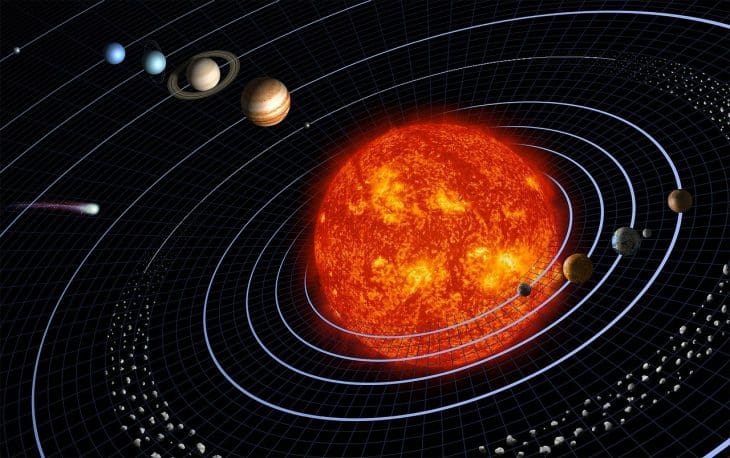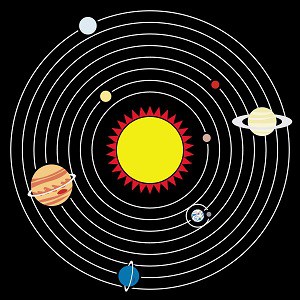
- Planets: 8 (Mercury, Venus, Earth, Mars, Jupiter, Saturn, Uranus, Neptune)
- Definition: Collection of 8 planets and their moons in orbit around the sun
- Largest Moon: Ganymede of Jupiter
- Formation: Formed from the gravitational collapse of a giant molecular cloud
- Largest Planet: Jupiter
- Hottest Planet: Venus
- Smallest Planet: Mercury
- Age: 4.6 billion years
- Most Moons: Jupiter, 67 moons
- Stars: 1 (Sun)
- Mass: The Sun Provides Most of Our Solar System’s Mass
- Planets: Venus Is the Hottest Planet
- Orbits: Mercury’s Days Last for 58 Earth Days
- Planets: Seasons on Uranus Last 21 Years
- Planets: Pluto Isn’t A Planet
- Elements: Planets Are Made of Rock or Gas
- Statistics: There Are 100 Billion Solar Systems in the Milky Way
- Definition: It’s Hard to Define a Planet
- Moons: Jupiter Has 67 Moons
- Rings: Saturn Isn’t the Only Planet With Rings
- The Solar System Is Always Moving
- We Are Probably Not Alone in the Universe
- Jupiter Is Earth’s Hero
- Almost Every Object Orbits the Same Way
- Jupiter’s Red Spot Is More Than Meets the Eye
- The Sun Provides Most of Our Solar System’s Mass
The Sun Provides Most of Our Solar System’s Mass
According to solar system facts, 99.86% of our solar system’s mass is made of the Sun, which is the only star in our solar system. Planets, dwarf planets, moons and asteroids all orbit around the Sun. Earth is actually considered to be inside the Sun’s atmosphere, so it can be said that we live inside of the Sun.
Venus Is the Hottest Planet

Many might think that Mercury would be the hottest planet since it is closest to the Sun, but Venus is actually the hottest, with an average temperature of 860 degrees Fahrenheit. Mercury only has a very thin atmosphere to hold in heat, while Venus has a very thick atmosphere that acts like a blanket, trapping in all the warmth from the Sun.
Mercury’s Days Last for 58 Earth Days
A day on any planet is measured by one full rotation of the planet on its own axis. On Earth, this takes about 24 hours. On Mercury, one full rotation, or day, takes 58 Earth days. Years are measured by how long each planet takes to fully rotate around the Sun. Mercury only takes 88 Earth days to complete its orbit. This means, somewhat confusingly, that Mercury technically has fewer than two days per year.
Seasons on Uranus Last 21 Years
Just as Mercury has a shorter orbit, planets that are farther away have longer orbits. Uranus, for example, takes 84 Earth years to make one rotation around the Sun. Therefore, one season on Uranus lasts for about 21 years. Because of the planet’s axis and tilt direction, some parts of the planet can go an entire season without any sunlight.
Pluto Isn’t A Planet
For years, Pluto was considered to be the ninth planet. More research showed though that Pluto was too small to be considered a true planet and it was downgraded to a dwarf planet. Its estimated size is 1,400 miles across, making it smaller than the United States. As of 2008, there are five dwarf planets in our solar system. These are: Pluto, Ceres, Eric, Makemake and Eris.
Planets Are Made of Rock or Gas

Solar system facts tell us that the most inner planets – Mercury, Venus, Earth and Mars – are mostly made up of rock and metal. The outer planets – Jupiter, Saturn, Uranus and Neptune – are mostly made up of hydrogen, helium and other gases. Earth is a little different, however and is mostly made up of iron, oxygen, silicon, magnesium and aluminum. These elements are very rare throughout the rest of the solar system.
There Are 100 Billion Solar Systems in the Milky Way
Before high-powered telescopes and satellites, it was thought that our solar system was the only one in existence. But we now know that there are over 550 planets that orbit far away stars, leading scientists to believe that there may be as many as 100 billion solar systems in the Milky Way galaxy.
It’s Hard to Define a Planet
Planets were originally only considered so if they had a moon orbiting them. However, solar system facts show us that Mercury and Venus do not have moons. The scientific community still does not completely agree on a single definition of a planet. The International Astronomical Union (IAU) stated that a planet orbits the Sun, has enough mass for its gravity to make it round in shape, and has cleared smaller objects from its orbit, but some astronomers do not support this definition.
Jupiter Has 79 Moons

Jupiter is the largest planet in the solar system and also has the highest number of moons. Seventy-nine moons orbit the planet, which, due to its size, has a very strong gravitational pull. Scientists explain Jupiter’s gravitational force as a type of space vacuum that picks up debris in space.
Saturn Isn’t the Only Planet With Rings
Saturn famously has rings of ice and dust that are visible from Earth. Many might assume that Saturn is the only planet with these rings, but Uranus, Neptune and Jupiter all have rings as well. Uranus’ rings are vertical, which gives the illusion that the planet has fallen over. Jupiter and Neptune’s rings are very faint and difficult to see, but certainly exist.
The Solar System Is Always Moving
The Earth is never still, and neither are any of the other planets or objects in the solar system. The Milky Way rotates at nearly 140 miles per second, while moving forward at 200 miles per second. This means that even while you are sitting on your couch, you are technically moving 12,000 miles each minute.
We Are Probably Not Alone in the Universe
Scientists have determined that there are at least 100 billion galaxies in the universe. Our galaxy alone has 300 billion stars and it can be supposed that each would have a planet or two at least. While there is no proof yet, chances are that there is at least one other planet out there supporting some type of life.
Jupiter Is Earth’s Hero
It is believed by many scientists that Jupiter has probably saved the Earth from certain destruction by comets several times throughout history. A comet discovered in 1770 was headed straight for Earth but never hit. Another comet discovered by Pierre-simon Laplace was headed towards Earth, but was sucked into Jupiter’s gravitational field. This probably happened in 1770 as well, and chances are similar events have taken place at plenty of other times.
Almost Every Object Orbits the Same Way
Solar system facts show that almost all the planets orbit the Sun in a similar fashion. The exception to this rule is Venus, which rotates anti-clockwise. The reason for this is unknown, but many scientist speculate that it may be due to a large collision in its early history.
Jupiter’s Red Spot Is More Than Meets the Eye
Most associate Jupiter with the large – and highly visible – red spot that appears to be located on its surface. However, this spot is actually a huge storm that is larger than Earth and has been continuously raging for hundreds of years.
Solar System Facts – Facts about the Solar System Summary
 Solar system facts tell us all about our unique grouping of planets, moons and other objects that all orbit around the Sun. Learn about unique differences between the planets, and how they all work together to create our solar system.
Solar system facts tell us all about our unique grouping of planets, moons and other objects that all orbit around the Sun. Learn about unique differences between the planets, and how they all work together to create our solar system.
Was this page helpful?
Our commitment to delivering trustworthy and engaging content is at the heart of what we do. Each fact on our site is contributed by real users like you, bringing a wealth of diverse insights and information. To ensure the highest standards of accuracy and reliability, our dedicated editors meticulously review each submission. This process guarantees that the facts we share are not only fascinating but also credible. Trust in our commitment to quality and authenticity as you explore and learn with us.


